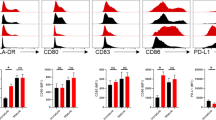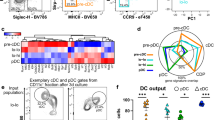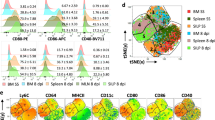Abstract
Circulating monocytes (Mos) may continuously repopulate macrophage (MAC) or dendritic cell (DC) populations to maintain homeostasis. MACs and DCs are specialized cells that play different and complementary immunological functions. Accordingly, they present distinct migratory properties. Specifically, whereas MACs largely remain in tissues, DCs are capable of migrating from peripheral tissues to lymphoid organs. The aim of this work was to analyze the expression of the fractalkine receptor (CX3CR1) during the monocytic differentiation process. Freshly isolated Mos express high levels of both CX3CR1 mRNA and protein. During the Mo differentiation process, CX3CR1 is downregulated in both DCs and MACs. However, MACs showed significantly higher CX3CR1 expression levels than did DC. We also observed an antagonistic CX3CR1 regulation by interferon (IFN)-γ and interleukin (IL)-4 during MAC activation through the classical and alternative MAC pathways, respectively. IFN-γ inhibited the loss of CX3CR1, but IL-4 induced it. Additionally, we demonstrated an association between CX3CR1 expression and apoptosis prevention by soluble fractalkine (sCX3CL1) in Mos, DCs and MACs. This is the first report demonstrating sequential and differential CX3CR1 modulation during Mo differentiation. Most importantly, we demonstrated a functional link between CX3CR1 expression and cell survival in the presence of sCX3CL1.
This is a preview of subscription content, access via your institution
Access options
Subscribe to this journal
Receive 12 digital issues and online access to articles
$119.00 per year
only $9.92 per issue
Buy this article
- Purchase on Springer Link
- Instant access to full article PDF
Prices may be subject to local taxes which are calculated during checkout





Similar content being viewed by others
References
Fogg DK, Sibon C, Miled C, Jung S, Aucouturier P, Littman DR et al. A clonogenic bone marrow progenitor specific for macrophages and dendritic cells. Science 2006; 311: 83–87.
Whitelaw DM . Observations on human monocyte kinetics after pulse labeling. Cell Tissue Kinet 1972; 5: 311–317.
Ziegler-Heitbrock HW . Definition of human blood monocytes. J Leukoc Biol 2000; 67: 603–606.
Tacke F, Randolph GJ . Migratory fate and differentiation of blood monocyte subsets. Immunobiology 2006; 211: 609–618.
Leon B, Lopez-Bravo M, Ardavin C . Monocyte-derived dendritic cells. Semin Immunol 2005; 17: 313–318.
Delamarre L, Pack M, Chang H, Mellman I, Trombetta ES . Differential lysosomal proteolysis in antigen-presenting cells determines antigen fate. Science 2005; 307: 1630–1634.
Jung YJ, Woo SY, Ryu KH, Chung WS, Kie JH, Seoh JY . Functional maturation of myeloid cells during in vitro differentiation from human cord blood CD34+ cells. Haematologica 2002; 87: 1222–1223.
Albert ML, Sauter B, Bhardwaj N . Dendritic cells acquire antigen from apoptotic cells and induce class I-restricted CTLs. Nature 1998; 392: 86–89.
Savill J, Dransfield I, Gregory C, Haslett C . A blast from the past: clearance of apoptotic cells regulates immune responses. Nat Rev Immunol 2002; 2: 965–975.
Trombetta ES, Ebersold M, Garrett W, Pypaert M, Mellman I . Activation of lysosomal function during dendritic cell maturation. Science 2003; 299: 1400–1403.
Randolph GJ, Angeli V, Swartz MA . Dendritic-cell trafficking to lymph nodes through lymphatic vessels. Nat Rev Immunol 2005; 5: 617–628.
Imhof BA, Aurrand-Lions M . Adhesion mechanisms regulating the migration of monocytes. Nat Rev Immunol 2004; 4: 432–444.
Gordon S, Taylor PR . Monocyte and macrophage heterogeneity. Nat Rev Immunol 2005; 5: 953–964.
Yano R, Yamamura M, Sunahori K, Takasugi K, Yamana J, Kawashima M et al. Recruitment of CD16+ monocytes into synovial tissues is mediated by fractalkine and CX3CR1 in rheumatoid arthritis patients. Acta Med Okayama 2007; 61: 89–98.
Bazan JF, Bacon KB, Hardiman G, Wang W, Soo K, Rossi D et al. A new class of membrane-bound chemokine with a CX3C motif. Nature 1997; 385: 640–644.
Pan Y, Lloyd C, Zhou H, Dolich S, Deeds J, Gonzalo JA et al. Neurotactin, a membrane-anchored chemokine upregulated in brain inflammation. Nature 1997; 387: 611–617.
Muehlhoefer A, Saubermann LJ, Gu X, Luedtke-Heckenkamp K, Xavier R, Blumberg RS et al. Fractalkine is an epithelial and endothelial cell-derived chemoattractant for intraepithelial lymphocytes in the small intestinal mucosa. J Immunol 2000; 164: 3368–3376.
Lucas AD, Chadwick N, Warren BF, Jewell DP, Gordon S, Powrie F et al. The transmembrane form of the CX3CL1 chemokine fractalkine is expressed predominantly by epithelial cells in vivo. Am J Pathol 2001; 158: 855–866.
Kanazawa N, Nakamura T, Tashiro K, Muramatsu M, Morita K, Yoneda K et al. Fractalkine and macrophage-derived chemokine: T cell-attracting chemokines expressed in T cell area dendritic cells. Eur J Immunol 1999; 29: 1925–1932.
Papadopoulos EJ, Sassetti C, Saeki H, Yamada N, Kawamura T, Fitzhugh DJ et al. Fractalkine, a CX3C chemokine, is expressed by dendritic cells and is up-regulated upon dendritic cell maturation. Eur J Immunol 1999; 29: 2551–2559.
Harrison JK, Jiang Y, Chen S, Xia Y, Maciejewski D, McNamara RK et al. Role for neuronally derived fractalkine in mediating interactions between neurons and CX3CR1-expressing microglia. Proc Natl Acad Sci USA 1998; 95: 10896–10901.
Yoshikawa M, Nakajima T, Matsumoto K, Okada N, Tsukidate T, Iida M et al. TNF-alpha and IL-4 regulate expression of fractalkine (CX3CL1) as a membrane-anchored proadhesive protein and soluble chemotactic peptide on human fibroblasts. FEBS Lett 2004; 561: 105–110.
Imaizumi T, Yoshida H, Satoh K . Regulation of CX3CL1/fractalkine expression in endothelial cells. J Atheroscler Thromb 2004; 11: 15–21.
Imai T, Hieshima K, Haskell C, Baba M, Nagira M, Nishimura M et al. Identification and molecular characterization of fractalkine receptor CX3CR1, which mediates both leukocyte migration and adhesion. Cell 1997; 91: 521–530.
Combadiere C, Salzwedel K, Smith ED, Tiffany HL, Berger EA, Murphy PM . Identification of CX3CR1. A chemotactic receptor for the human CX3C chemokine fractalkine and a fusion coreceptor for HIV-1. J Biol Chem 1998; 273: 23799–23804.
Postea O, Vasina EM, Cauwenberghs S, Projahn D, Liehn EA, Lievens D et al. Contribution of platelet CX3CR1 to platelet–monocyte complex formation and vascular recruitment during hyperlipidemia. Arterioscler Thromb Vasc Biol 2012; 32: 1186–1193.
Sanchez-Torres C, Garcia-Romo GS, Cornejo-Cortes MA, Rivas-Carvalho A, Sanchez-Schmitz G . CD16+ and CD16− human blood monocyte subsets differentiate in vitro to dendritic cells with different abilities to stimulate CD4+ T cells. Int Immunol 2001; 13: 1571–1581.
Sallusto F, Lanzavecchia A . Efficient presentation of soluble antigen by cultured human dendritic cells is maintained by granulocyte/macrophage colony-stimulating factor plus interleukin 4 and downregulated by tumor necrosis factor alpha. J Exp Med 1994; 179: 1109–1118.
Piemonti L, Bernasconi S, Luini W, Trobonjaca Z, Minty A, Allavena P et al. IL-13 supports differentiation of dendritic cells from circulating precursors in concert with GM-CSF. Eur Cytokine Netw 1995; 6: 245–252.
Pulendran B, Palucka K, Banchereau J . Sensing pathogens and tuning immune responses. Science 2001; 293: 253–256.
Matsuda S, Akagawa K, Honda M, Yokota Y, Takebe Y, Takemori T . Suppression of HIV replication in human monocyte-derived macrophages induced by granulocyte/macrophage colony-stimulating factor. AIDS Res Hum Retroviruses 1995; 11: 1031–1038.
Akagawa KS, Takasuka N, Nozaki Y, Komuro I, Azuma M, Ueda M et al. Generation of CD1+RelB+ dendritic cells and tartrate-resistant acid phosphatase-positive osteoclast-like multinucleated giant cells from human monocytes. Blood 1996; 88: 4029–4039.
Hardin JA, Downs JT . Isolation of human monocytes on re-orienting gradients of Percoll. J Immunol Methods 1981; 40: 1–6.
Bouhlel MA, Derudas B, Rigamonti E, Dievart R, Brozek J, Haulon S et al. PPARgamma activation primes human monocytes into alternative M2 macrophages with anti-inflammatory properties. Cell Metab 2007; 6: 137–143.
Mysliwska J, Ryba-Stanislawowska M, Smardzewski M, Slominski B, Mysliwiec M, Siebert J . Enhanced apoptosis of monocytes from complication-free juvenile-onset diabetes mellitus type 1 may be ameliorated by TNF-alpha inhibitors. Mediators Inflamm 2014; 2014: 946209.
Pachot A, Cazalis MA, Venet F, Turrel F, Faudot C, Voirin N et al. Decreased expression of the fractalkine receptor CX3CR1 on circulating monocytes as new feature of sepsis-induced immunosuppression. J Immunol 2008; 180: 6421–6429.
Koziolek MJ, Schmid H, Cohen CD, Blaschke S, Hemmerlein B, Zapf A et al. Potential role of fractalkine receptor expression in human renal fibrogenesis. Kidney Int 2007; 72: 599–607.
Ramos MV, Fernandez GC, Brando RJ, Panek CA, Bentancor LV, Landoni VI et al. Interleukin-10 and interferon-gamma modulate surface expression of fractalkine-receptor (CX3CR1) via PI3K in monocytes. Immunology 2010; 129: 600–609.
Liu X, Lu G, Shen J . Silencing CX3CR1 production modulates the interaction between dendritic and endothelial cells. Mol Biol Rep 2011; 38: 481–488.
Ahn JS, Agrawal B . IL-4 is more effective than IL-13 for in vitro differentiation of dendritic cells from peripheral blood mononuclear cells. Int Immunol 2005; 17: 1337–1346.
Chomarat P, Banchereau J . Interleukin-4 and interleukin-13: their similarities and discrepancies. Int Rev Immunol 1998; 17: 1–52.
Stein M, Keshav S, Harris N, Gordon S . Interleukin 4 potently enhances murine macrophage mannose receptor activity: a marker of alternative immunologic macrophage activation. J Exp Med 1992; 176: 287–292.
Landsman L, Bar-On L, Zernecke A, Kim KW, Krauthgamer R, Shagdarsuren E et al. CX3CR1 is required for monocyte homeostasis and atherogenesis by promoting cell survival. Blood 2009; 113: 963–972.
Ludwig A, Berkhout T, Moores K, Groot P, Chapman G . Fractalkine is expressed by smooth muscle cells in response to IFN-gamma and TNF-alpha and is modulated by metalloproteinase activity. J Immunol 2002; 168: 604–612.
Dragomir E, Manduteanu I, Calin M, Gan AM, Stan D, Koenen RR et al. High glucose conditions induce upregulation of fractalkine and monocyte chemotactic protein-1 in human smooth muscle cells. Thromb Haemost 2008; 100: 1155–1165.
Barlic J, Zhang Y, Murphy PM . Atherogenic lipids induce adhesion of human coronary artery smooth muscle cells to macrophages by up-regulating chemokine CX3CL1 on smooth muscle cells in a TNFalpha–NFkappaB-dependent manner. J Biol Chem 2007; 282: 19167–19176.
Umehara H, Bloom ET, Okazaki T, Nagano Y, Yoshie O, Imai T . Fractalkine in vascular biology: from basic research to clinical disease. Arterioscler Thromb Vasc Biol 2004; 24: 34–40.
Cockwell P, Chakravorty SJ, Girdlestone J, Savage CO . Fractalkine expression in human renal inflammation. J Pathol 2002; 196: 85–90.
Hatori K, Nagai A, Heisel R, Ryu JK, Kim SU . Fractalkine and fractalkine receptors in human neurons and glial cells. J Neurosci Res 2002; 69: 418–426.
Shulby SA, Dolloff NG, Stearns ME, Meucci O, Fatatis A . CX3CR1–fractalkine expression regulates cellular mechanisms involved in adhesion, migration, and survival of human prostate cancer cells. Cancer Res 2004; 64: 4693–4698.
Tacke F, Alvarez D, Kaplan TJ, Jakubzick C, Spanbroek R, Llodra J et al. Monocyte subsets differentially employ CCR2, CCR5, and CX3CR1 to accumulate within atherosclerotic plaques. J Clin Invest 2007; 117: 185–194.
Tanaka T, Bai Z, Srinoulprasert Y, Yang BG, Hayasaka H, Miyasaka M . Chemokines in tumor progression and metastasis. Cancer Sci 2005; 96: 317–322.
Bjerkeli V, Damas JK, Fevang B, Holter JC, Aukrust P, Froland SS . Increased expression of fractalkine (CX3CL1) and its receptor, CX3CR1, in Wegener's granulomatosis—possible role in vascular inflammation. Rheumatology (Oxford) 2007; 46: 1422–1427.
Maciejewski-Lenoir D, Chen S, Feng L, Maki R, Bacon KB . Characterization of fractalkine in rat brain cells: migratory and activation signals for CX3CR-1-expressing microglia. J Immunol 1999; 163: 1628–1635.
Zanchi C, Zoja C, Morigi M, Valsecchi F, Liu XY, Rottoli D et al. Fractalkine and CX3CR1 mediate leukocyte capture by endothelium in response to Shiga toxin. J Immunol 2008; 181: 1460–1469.
Ramos MV, Fernandez GC, Patey N, Schierloh P, Exeni R, Grimoldi I et al. Involvement of the fractalkine pathway in the pathogenesis of childhood hemolytic uremic syndrome. Blood 2007; 109: 2438–2445.
Ancuta P, Rao R, Moses A, Mehle A, Shaw SK, Luscinskas FW et al. Fractalkine preferentially mediates arrest and migration of CD16+ monocytes. J Exp Med 2003; 197: 1701–1707.
Dichmann S, Herouy Y, Purlis D, Rheinen H, Gebicke-Harter P, Norgauer J . Fractalkine induces chemotaxis and actin polymerization in human dendritic cells. Inflamm Res 2001; 50: 529–533.
Sozzani S, Allavena P, D'Amico G, Luini W, Bianchi G, Kataura M et al. Differential regulation of chemokine receptors during dendritic cell maturation: a model for their trafficking properties. J Immunol 1998; 161: 1083–1086.
Geissmann F, Manz MG, Jung S, Sieweke MH, Merad M, Ley K . Development of monocytes, macrophages, and dendritic cells. Science 2010; 327: 656–661.
Liu K, Victora GD, Schwickert TA, Guermonprez P, Meredith MM, Yao K et al. In vivo analysis of dendritic cell development and homeostasis. Science 2009; 324: 392–397.
Rojas D, Krishnan R . IFN-gamma generates maturation-arrested dendritic cells that induce T cell hyporesponsiveness independent of Foxp3+ T-regulatory cell generation. Immunol Lett 2010; 132: 31–37.
Rojas-Canales D, Krishnan R, Jessup CF, Coates PT . Early exposure of interferon-gamma inhibits signal transducer and activator of transcription-6 signalling and nuclear factor kappaB activation in a short-term monocyte-derived dendritic cell culture promoting ‘FAST' regulatory dendritic cells. Clin Exp Immunol 2012; 167: 447–458.
van der Velden VH, Naber BA, Wierenga-Wolf AF, Debets R, Savelkoul HF, Overbeek SE et al. Interleukin 4 receptors on human bronchial epithelial cells. An in vivo and in vitro analysis of expression and function. Cytokine 1998; 10: 803–813.
Heller NM, Qi X, Gesbert F, Keegan AD . The extracellular and transmembrane domains of the gammaC and interleukin (IL)-13 receptor alpha1 chains, not their cytoplasmic domains, dictate the nature of signaling responses to IL-4 and IL-13. J Biol Chem 2012; 287: 31948–31961.
Heller NM, Qi X, Junttila IS, Shirey KA, Vogel SN, Paul WE et al. Type I IL-4Rs selectively activate IRS-2 to induce target gene expression in macrophages. Sci Signal 2008; 1: ra17.
Kasama T, Wakabayashi K, Sato M, Takahashi R, Isozaki T . Relevance of the CX3CL1/fractalkine–CX3CR1 pathway in vasculitis and vasculopathy. Transl Res 2010; 155: 20–26.
Fraticelli P, Sironi M, Bianchi G, D'Ambrosio D, Albanesi C, Stoppacciaro A et al. Fractalkine (CX3CL1) as an amplification circuit of polarized Th1 responses. J Clin Invest 2001; 107: 1173–1181.
Xue J, Schmidt SV, Sander J, Draffehn A, Krebs W, Quester I et al. Transcriptome-based network analysis reveals a spectrum model of human macrophage activation. Immunity 2014; 40: 274–288.
Martinez FO, Gordon S . The M1 and M2 paradigm of macrophage activation: time for reassessment. F1000Prime Rep 2014; 6: 13.
Acknowledgements
The authors thank Marta Felippo, Nora Galassi and Norma Riera for their excellent technical assistance. The authors also thank Fundación de la Hemofilia and Academia Nacional de Medicina for the use of the FACScan flow cytometer. This work was supported by grants from Consejo Nacional de Investigaciones Científicas y Tecnológicas to MVR and Agencia Nacional de Promoción Científica y Tecnológica to MVR and MSP, Argentina.
Author information
Authors and Affiliations
Corresponding author
Ethics declarations
Competing interests
None of the authors have any potential financial conflict of interest related to this manuscript.
Additional information
Supplementary Information accompanies the paper on Cellular & Molecular Immunology's website. (http://www.nature.com/cmi).
Supplementary information
Rights and permissions
About this article
Cite this article
Panek, C., Ramos, M., Mejias, M. et al. Differential expression of the fractalkine chemokine receptor (CX3CR1) in human monocytes during differentiation. Cell Mol Immunol 12, 669–680 (2015). https://doi.org/10.1038/cmi.2014.116
Received:
Revised:
Accepted:
Published:
Issue Date:
DOI: https://doi.org/10.1038/cmi.2014.116
Keywords
This article is cited by
-
Interleukin-6 mediates neutrophil mobilization from bone marrow in pulmonary hypertension
Cellular & Molecular Immunology (2021)
-
Elevated soluble TNFα levels and upregulated TNFα mRNA expression in purified peripheral blood monocyte subsets associated with high-grade hepatocellular carcinoma
Journal of Inflammation (2020)
-
Metastatic breast cancer cells induce altered microglial morphology and electrical excitability in vivo
Journal of Neuroinflammation (2020)
-
Hemodialysis-related changes in phenotypical features of monocytes
Scientific Reports (2018)
-
Cellular and molecular regulation of innate inflammatory responses
Cellular & Molecular Immunology (2016)



